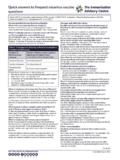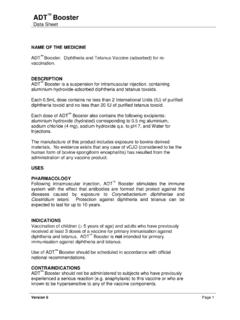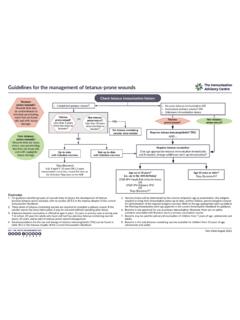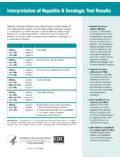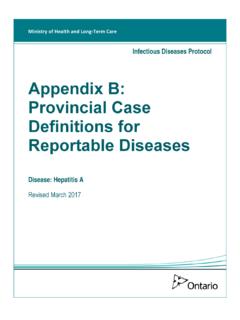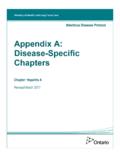Transcription of Immunisation for the low birth weight and/or preterm ...
1 Fact sheet September 2017 Executive summary Premature and low birth weight infants are at greater risk of increased mortality and morbidity from vaccine preventable diseases. With the exception of BCG, immunisations should be given according to the National Immunisation Schedule at the appropriate chronological age. Do not adjust age for preterm birth , National Immunisation Schedule vaccines start at 6 weeks of age from the date of birth . The usual vaccine dosage should be immunogenicity Inferior immune response to some vaccines although evidence suggests the response is still safety Immunisation in these infants is safe and effective. However, post-vaccination apnoea with or without associated bradycardia up to 48 hours post- Immunisation may be increased in some Factors possibly associated with an increased incidence of post- Immunisation apnoea: Apnoea within the 24 hour period before Immunisation .
2 More severe illness at birth . Chronological age less than 67 days and/or earlier gestational age in infants with a birth weight of less than 1500g. An apnoeic episode following the first Immunisation monitoring Consider after the first Immunisation event. Consider after subsequent Immunisation events when an infant has experienced apnoea after their first Immunisation event. No long term sequelae have been associated with post Immunisation apnoeic events. Immunisation should not be withheld or administration Preferred site for intramuscular Immunisation is the vastus lateralis. A 23 25 gauge x 16mm needle inserted at a 90 angle to the skin is usually adequate.
3 Targeted Immunisation or cocooning Consider pertussis and influenza Immunisation for all close contacts. These vaccines are not usually funded for these groups by the Ministry of for individual vaccinesInfants born to hepatitis B carrier mothers Give hepatitis B immunoglobulin (HBIG) and a hepatitis B Immunisation (HBvaxPRO ) within 12 hours of birth regardless of birth weight , followed by Three doses of hepatitis B containing vaccine (DTaP-IPV-HepB/Hib [Infanrix -hexa]) beginning at 6 weeks of age, regardless of birth weight . Serology testing for hepatitis B infection (HBsAg) and immunity (antiHBs) is recommended at 9 months of of non- hepatitis B carrier mothers Three doses of hepatitis B containing vaccine (DTaP-IPV-HepB/Hib [Infanrix-hexa]) beginning at 6 weeks of age, regardless of birth (BCG) Eligible infants born at 34 weeks gestation or later can receive the BCG vaccine soon after birth .
4 Eligible infants born before 34 weeks gestation should have their BCG delayed until 34 weeks gestational age. Diphtheria, tetanus, pertussis, polio and Haemophilus influenzae type b (Hib) Three doses beginning at 6 weeks of age. Administer as DTaP-IPV-HepB/Hib (Infanrix-hexa).Pneumococcal disease Infants who are not eligible for the high-risk pneumococcal Immunisation programme Give the routine National Immunisation Schedule pneumococcal conjugate vaccine (PCV10/Synflorix ) at 6 weeks, 3 months, 5 months and 15 months of age. Infants who are eligible for the high-risk pneumococcal Immunisation programme PCV13/Prevenar 13 replaces PCV10/Synflorix at 6 weeks, 3 months, 5 months and 15 months of age.
5 Two 23-valent pneumococcal polysaccharide vaccine doses (23 PPV/Pneumovax 23) are recommended and funded if the infant continues to be at high-risk of pneumococcal disease, the first at 2 years of age and the second five years after the (RV1) Two doses of rotavirus vaccine (Rotarix ) beginning at 6 weeks of age. Infants in hospital at 6 weeks of age should receive the first Rotarix dose on time. There is a theoretical risk of disease resulting from horizontal transfer of the vaccine virus. If standard precautions are maintained, the risk of transmission of vaccine strain rotavirus will be Influenza vaccine annually from 6 months of age. preterm birth alone does not meet the eligibility criteria for receipt of funded vaccine.
6 Two doses of vaccine administered one month apart in the first year, then one dose annually in each subsequent for the low birth weightand/or preterm infant (updated September 2017)Fact sheet September 2017 Young infants are especially vulnerable to a number of vaccine preventable diseases, particularly pertussis (whooping cough), Haemophilus influenzae type b (Hib) disease, pneumococcal disease and influenza. preterm and low birth weight infants have an even higher risk than full term infants of developing serious complications from vaccine preventable birth is defined as birth before 37 weeks gestation and low birth weight refers to infants born weighing less than 2500 grams.
7 With the exception of the BCG vaccine, gestational age and birth weight are not limiting factors when deciding whether a clinically stable preterm infant is to be immunised at the appropriate chronological age, following the same Immunisation schedule as infants born full-term. The recommended dose of each vaccine should be used, doses should not be immunity in preterm infantsTransplacental transfer of maternal immunoglobulin G (IgG) that can protect an infant against some vaccine preventable diseases is affected by a range of factors including the mother s past exposure to the disease and vaccination history, antibody half-life, and the infant s gestational age.
8 Infants born at less than 32 weeks gestation have significantly less IgG compared with those born at 32 36 weeks. Furthermore, IgG wanes more rapidly rendering preterm infants at increased and earlier risk for vaccine preventable immunogenicityPreterm infants have an inferior immune response to some vaccines although evidence suggests that the response is still adequate for safetyVaccines in preterm and/or low birth weight infants have excellent safety profiles, comparable to those in full term infants, with the exception of a possible increase in apnoea with or without associated bradycardia up to 48 hours that have been identified as possibly being associated with an increased incidence of post- Immunisation apnoea include apnoea within the 24 hour period before Immunisation , more severe illness at birth , chronological age less than 67 days, and/or earlier gestational age in infants with a birth weight of less than 1500g.
9 Although apnoeic episodes are not necessarily causally associated with Immunisation , an apnoeic episode following the first Immunisation event is a significant risk factor for an apnoeic episode following the second Immunisation event. No long term sequelae have been associated with post Immunisation apnoeic monitoringApnoea monitoring of preterm and/or low birth weight infants, particularly those with a history of respiratory immaturity, should be considered after the first Immunisation event. When an infant has experienced apnoea after their first Immunisation event, apnoea monitoring (for both medical reasons and to maintain parental confidence in Immunisation ) should be considered after subsequent Immunisation events.
10 Immunisation should not be withheld or administration The preferred site for intramuscular Immunisation in preterm or low birth weight infants is the same as for full term infants, the vastus lateralis. A 23 25 gauge x 16mm needle inserted at a 90 angle to the skin is usually adequate. Targeted Immunisation or cocooningResearch suggests that most infants acquire diseases such as whooping cough and influenza from family members. Cocooning or targeted Immunisation involves ensuring siblings are up to date with their immunisations, and immunising the infant s close contacts (parents, grandparents and carers) to reduce the risk of disease exposure for the infant.

